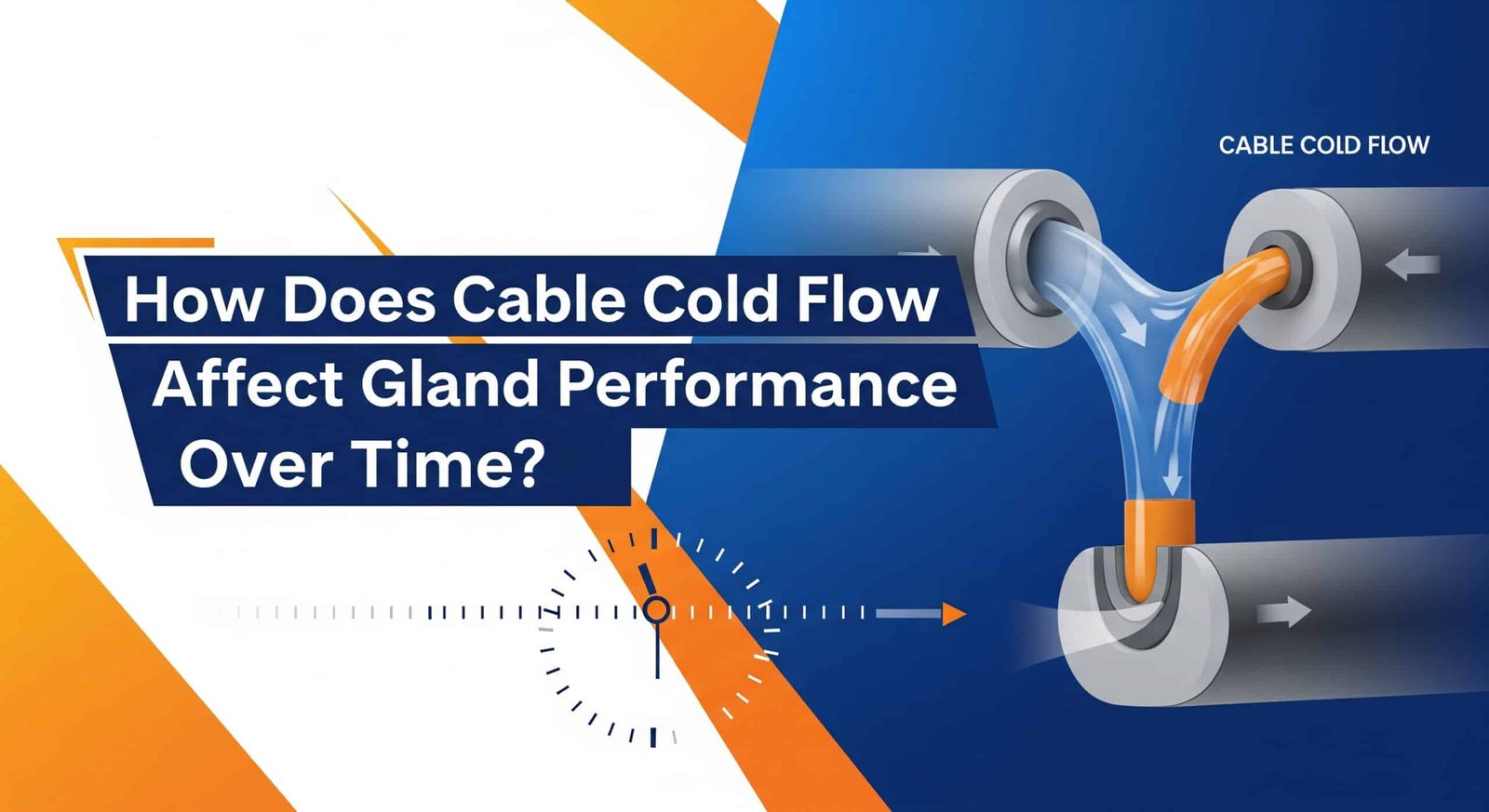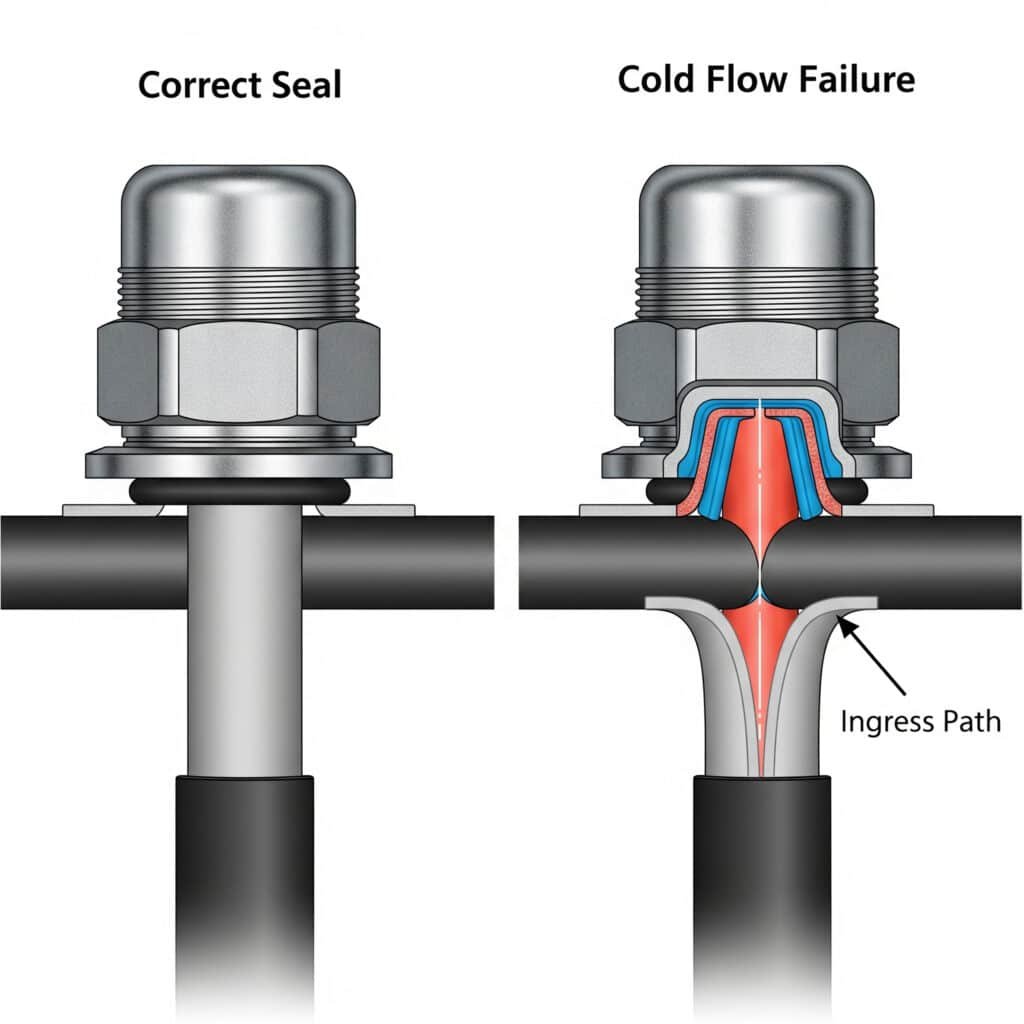
Cable cold flow causes gradual deformation of cable jackets under sustained compression forces, leading to seal loosening, reduced IP ratings, compromised strain relief, and potential ingress failures that can damage sensitive equipment, create safety hazards, and require costly maintenance interventions when cable glands lose their grip and environmental protection over extended operating periods.
Cable cold flow significantly impacts gland performance by causing gradual cable deformation under sustained compression, reducing sealing effectiveness, compromising strain relief capabilities, and potentially leading to ingress protection failures over time, requiring careful material selection, proper installation techniques, and regular maintenance to maintain reliable long-term performance and prevent costly equipment damage or safety incidents. Understanding cold flow effects is essential for reliable cable gland installations.
Having analyzed thousands of cable gland failures across industrial installations from Norway’s offshore platforms to Saudi Arabia’s petrochemical complexes, I’ve discovered that cold flow-related issues account for nearly 40% of long-term seal failures1. Let me share the critical insights that can prevent these costly problems and ensure lasting performance.
Table of Contents
- What Is Cable Cold Flow and Why Does It Matter?
- How Does Cold Flow Affect Different Cable Gland Types?
- What Factors Accelerate Cable Cold Flow in Glands?
- How Can You Prevent Cold Flow-Related Gland Failures?
- What Are the Best Practices for Long-Term Performance?
- FAQs About Cable Cold Flow and Gland Performance
What Is Cable Cold Flow and Why Does It Matter?
Cable cold flow is the gradual deformation of polymer cable jackets under sustained mechanical stress at normal operating temperatures, causing dimensional changes that compromise cable gland sealing integrity, reduce strain relief effectiveness, and can lead to environmental ingress, electrical faults, and safety hazards over extended periods, making it a critical consideration for reliable long-term cable gland performance.
Understanding cold flow mechanisms is essential for preventing costly failures and ensuring reliable installations.
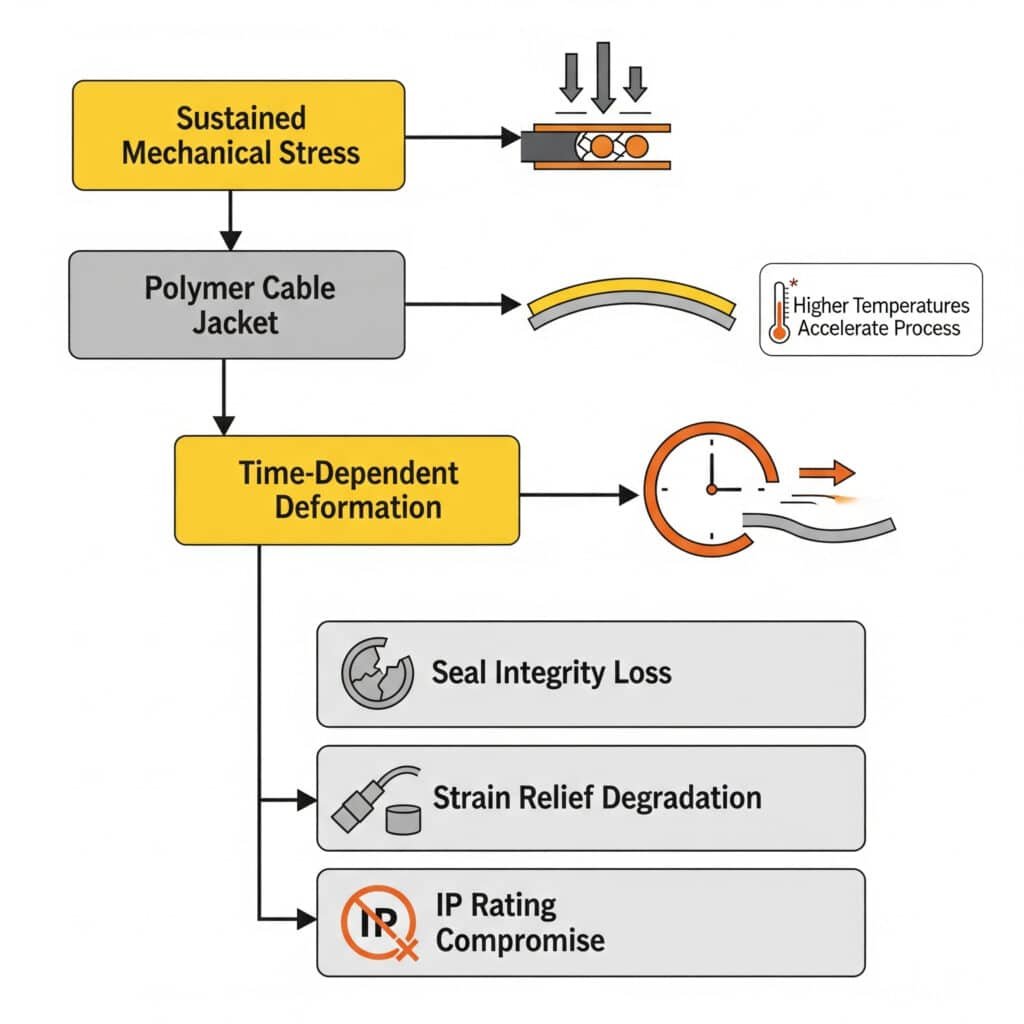
Understanding the Cold Flow Mechanism
Polymer Behavior: Cable jacket materials, particularly thermoplastics like PVC, polyethylene, and TPU, exhibit viscoelastic properties2 that cause gradual deformation under constant stress.
Time-Dependent Deformation: Unlike elastic deformation that occurs instantly, cold flow develops slowly over months or years, making it difficult to detect during initial installation.
Stress Relaxation: As the cable deforms, the compression forces that maintain gland sealing gradually decrease, compromising environmental protection.
Temperature Dependency: Higher temperatures accelerate cold flow rates, making thermal management critical for long-term performance.
Impact on Cable Gland Performance
Seal Integrity Loss: As cables deform, the compression forces maintaining environmental seals decrease, potentially allowing moisture, dust, and contaminants to enter enclosures.
Strain Relief Degradation: Cold flow reduces the mechanical grip between cable and gland, compromising strain relief and potentially allowing cable pullout or damage.
IP Rating Compromise: Environmental protection ratings depend on maintained compression forces that cold flow gradually reduces over time.
Electrical Performance: In some cases, cold flow can affect cable geometry sufficiently to impact electrical characteristics or conductor integrity.
Material Susceptibility Factors
Polymer Type: Different cable jacket materials exhibit varying cold flow resistance, with some thermoplastics being particularly susceptible to deformation.
Plasticizer Content: Cables with high plasticizer content3 show greater cold flow tendencies, especially at elevated temperatures.
Filler Materials: The presence and type of filler materials can significantly influence cold flow resistance and long-term stability.
Manufacturing Quality: Processing conditions and quality control during cable manufacturing affect long-term dimensional stability.
Critical Applications Where Cold Flow Matters
| Application Type | Risk Level | Key Concerns | Monitoring Requirements |
|---|---|---|---|
| Outdoor Installations | High | Temperature cycling, UV exposure | Annual inspection |
| Industrial Process | Very High | Elevated temperatures, chemicals | Quarterly assessment |
| Marine Environments | High | Salt spray, temperature variation | Semi-annual checks |
| Underground Systems | Medium | Stable conditions, limited access | Extended intervals |
| HVAC Systems | High | Temperature cycling, vibration | Annual maintenance |
David, a maintenance manager at a large automotive plant in Detroit, Michigan, was experiencing recurring seal failures in cable glands serving robotic welding stations. The high ambient temperatures from welding operations were accelerating cold flow in PVC-jacketed cables, causing seal loosening within 18 months instead of the expected 5-year service life. We analyzed the failure patterns and recommended switching to cold flow-resistant cable materials and implementing temperature-controlled cable routing that extended seal life to over 7 years. 😊
How Does Cold Flow Affect Different Cable Gland Types?
Cold flow affects different cable gland types through varying mechanisms including compression seal loosening in standard glands, reduced gripping force in strain relief designs, compromised sealing in multi-seal systems, and differential expansion effects in metal versus plastic glands, with each type requiring specific considerations for material selection, installation techniques, and maintenance procedures to maintain long-term performance.
Understanding type-specific effects enables better gland selection and maintenance strategies.
Standard Compression Glands
Sealing Mechanism Impact: Traditional compression glands rely on sustained force to maintain seal integrity, making them particularly vulnerable to cold flow effects.
Compression Loss: As cable jackets deform, the compression nuts may require periodic retightening to maintain proper sealing force.
Seal Material Interaction: The combination of cable cold flow and seal material properties determines long-term sealing effectiveness.
Thread Engagement: Cold flow can affect the distribution of forces across threaded connections, potentially causing uneven wear or loosening.
Multi-Seal Cable Glands
Primary Seal Effects: Cold flow primarily affects the cable-to-gland interface seal, which is most dependent on sustained compression forces.
Secondary Seal Stability: Thread seals and gasket seals are generally less affected by cable cold flow but may experience secondary effects.
Seal Redundancy Benefits: Multiple sealing barriers can provide continued protection even if one seal is compromised by cold flow effects.
Maintenance Complexity: Multi-seal systems require more complex inspection and maintenance procedures to address cold flow impacts.
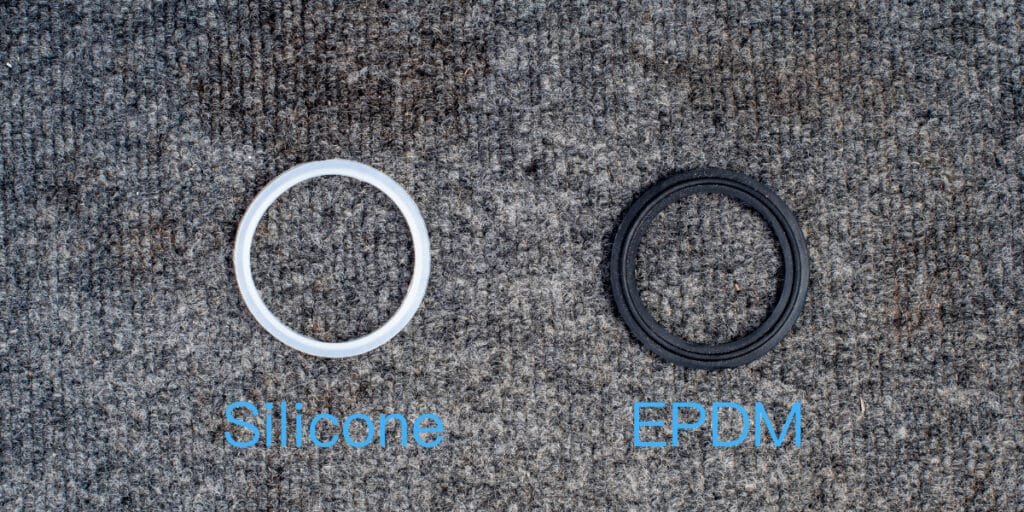
Strain Relief Glands
Gripping Force Reduction: Cold flow directly reduces the mechanical grip between cable and gland, compromising strain relief effectiveness.
Cable Pullout Risk: Severe cold flow can reduce gripping forces sufficiently to allow cable movement or pullout under mechanical stress.
Vibration Sensitivity: Reduced grip makes installations more sensitive to vibration-induced cable movement and fatigue.
Load Distribution: Cold flow changes how mechanical loads are distributed along the cable, potentially creating stress concentrations.
EMC and Screened Cable Glands
Screen Contact Integrity: Cold flow can affect the contact pressure between cable screens and gland grounding elements.
EMC Performance Degradation: Reduced contact pressure may compromise electromagnetic compatibility performance over time.
360-Degree Contact: Maintaining continuous circumferential contact becomes more challenging as cables deform.
Grounding Effectiveness: Electrical continuity for safety grounding may be affected by cold flow-induced contact changes.
Material-Specific Gland Considerations
Brass Glands: Thermal expansion differences between brass and cable materials can accelerate cold flow effects in temperature-varying environments.
Stainless Steel Glands: Lower thermal expansion coefficients may provide more stable compression forces as temperatures change.
Nylon Glands: Plastic glands may exhibit their own cold flow characteristics that interact with cable deformation.
Hybrid Designs: Glands combining different materials require careful consideration of differential expansion and cold flow effects.
Performance Monitoring Indicators
Visual Inspection Signs: Visible cable deformation, seal extrusion, or gap formation around cable entries indicate cold flow effects.
Torque Testing: Periodic torque checks can reveal compression loss due to cold flow-induced stress relaxation.
IP Rating Verification: Regular ingress protection testing can detect seal degradation before complete failure occurs.
Electrical Testing: For screened cables, periodic continuity and EMC testing can reveal contact degradation.
What Factors Accelerate Cable Cold Flow in Glands?
Factors that accelerate cable cold flow in glands include elevated operating temperatures, excessive compression forces during installation, chemical exposure that softens cable jackets, UV radiation degradation, mechanical vibration and stress cycling, poor cable material selection, and environmental conditions that promote polymer chain mobility, all of which can significantly reduce the time to seal failure and compromise long-term gland performance.
Identifying and controlling these factors is essential for reliable long-term performance.
Temperature-Related Acceleration
Thermal Energy Effects: Higher temperatures provide energy for polymer chain movement, accelerating the rate of cold flow deformation.
Arrhenius Relationship: Cold flow rates typically follow exponential relationships with temperature, meaning small temperature increases cause large acceleration. This is often described by the Arrhenius Relationship4.
Thermal Cycling Impact: Repeated heating and cooling cycles can accelerate cold flow through stress relaxation and recovery mechanisms.
Heat Source Proximity: Cable glands near heat sources like motors, transformers, or process equipment experience accelerated cold flow.
Mechanical Stress Factors
Over-Compression: Excessive installation torque creates higher stress levels that accelerate cold flow deformation rates.
Stress Concentration: Sharp edges or poor surface finishes can create localized high-stress areas that accelerate local deformation.
Dynamic Loading: Vibration, thermal expansion, and mechanical movement create cyclic stresses that accelerate cold flow processes.
Installation Quality: Poor installation practices can create uneven stress distributions that promote accelerated deformation.
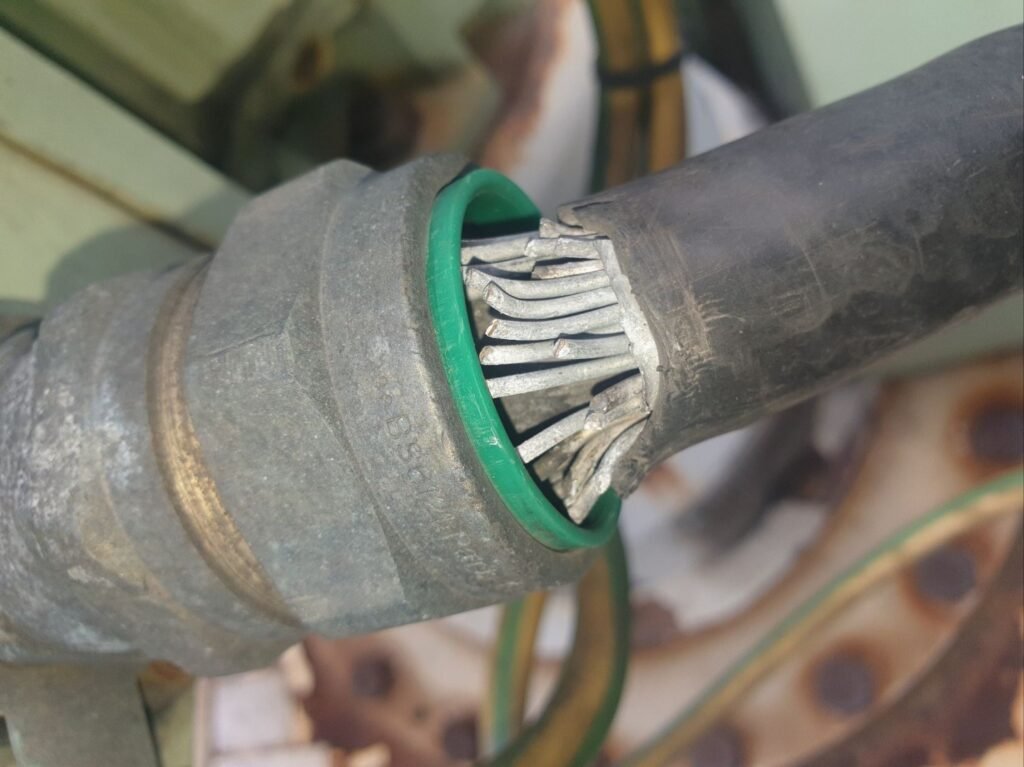
Environmental Acceleration Factors
Chemical Exposure: Solvents, oils, and other chemicals can plasticize cable jackets, making them more susceptible to cold flow.
UV Radiation: Ultraviolet exposure can degrade polymer chains, reducing cold flow resistance and accelerating deformation.
Humidity Effects: High humidity can affect some cable materials and potentially accelerate degradation processes.
Atmospheric Contamination: Industrial atmospheres containing acids, bases, or other reactive species can accelerate material degradation.
Material Property Influences
Plasticizer Migration: Loss of plasticizers over time can change material properties and affect cold flow characteristics.
Polymer Crystallinity: The degree of crystalline structure in cable jacket materials significantly affects cold flow resistance.
Molecular Weight: Lower molecular weight polymers generally exhibit higher cold flow rates than high molecular weight materials.
Cross-Linking Density: Cross-linked materials typically show better cold flow resistance than linear polymers.
Installation and Design Factors
Gland Selection: Inappropriate gland selection for the cable type and application can create conditions that accelerate cold flow.
Cable Preparation: Poor cable stripping or preparation can create stress concentrations that accelerate local deformation.
Routing Constraints: Tight bends or constrained cable routing can create additional stresses that accelerate cold flow.
Support Adequacy: Inadequate cable support can transfer mechanical loads to gland connections, accelerating deformation.
Quantitative Acceleration Factors
| Factor | Typical Acceleration | Measurement Method | Control Strategy |
|---|---|---|---|
| Temperature (+20°C) | 2-5x faster | Thermal monitoring | Heat shielding, ventilation |
| Over-torque (50%) | 1.5-3x faster | Torque measurement | Calibrated tools, training |
| Chemical Exposure | 3-10x faster | Material compatibility | Barrier protection, material selection |
| UV Exposure | 2-4x faster | UV measurement | Shielding, UV-resistant materials |
| Vibration | 1.5-2x faster | Vibration analysis | Damping, flexible connections |
Hassan, who operates a petrochemical facility in Kuwait, was experiencing premature cable gland failures in high-temperature process areas where ambient temperatures reached 70°C. The combination of heat and chemical vapors was accelerating cold flow in standard PVC cables, causing seal failures within 6 months. We conducted a comprehensive analysis and recommended switching to fluoropolymer-jacketed cables with specialized high-temperature glands, along with implementing thermal barriers and improved ventilation. This solution extended service life to over 5 years while maintaining reliable environmental protection.
How Can You Prevent Cold Flow-Related Gland Failures?
Preventing cold flow-related gland failures requires careful cable material selection, proper gland sizing and installation, controlled compression forces, environmental protection measures, regular maintenance schedules, and monitoring programs that detect early signs of deformation, combined with design strategies that accommodate expected cold flow while maintaining sealing integrity throughout the intended service life.
Proactive prevention is more cost-effective than reactive maintenance and replacement.
Material Selection Strategies
Cold Flow-Resistant Cables: Choose cable jacket materials with proven cold flow resistance for the specific operating environment and temperature range.
Cross-Linked Materials: Specify cross-linked polymers5 like XLPE or cross-linked polyethylene that offer superior dimensional stability under stress.
High-Performance Polymers: Consider fluoropolymers, polyurethanes, or other specialty materials for demanding applications with high cold flow risk.
Material Testing: Verify cold flow resistance through standardized testing or manufacturer data for specific operating conditions.
Gland Design and Selection
Controlled Compression Systems: Select glands designed to maintain optimal compression forces without over-stressing cable jackets.
Multiple Sealing Barriers: Use multi-seal designs that provide redundant protection if primary seals are affected by cold flow.
Strain Relief Integration: Choose glands with integrated strain relief that distributes mechanical loads over larger cable areas.
Material Compatibility: Ensure gland materials are compatible with cable jackets and won’t accelerate degradation through chemical interaction.
Installation Best Practices
Torque Control: Use calibrated torque tools and follow manufacturer specifications to avoid over-compression that accelerates cold flow.
Proper Cable Preparation: Ensure clean, square cuts and proper stripping to minimize stress concentrations during installation.
Environmental Protection: Install heat shields, UV protection, or chemical barriers where environmental factors could accelerate cold flow.
Quality Verification: Perform initial sealing tests and document baseline performance for future comparison.
Monitoring and Maintenance Programs
Regular Inspection Schedules: Establish inspection intervals based on operating conditions, with more frequent checks in high-risk environments.
Performance Testing: Periodically test IP ratings, torque retention, and other performance parameters to detect degradation.
Predictive Maintenance: Use trending data to predict when maintenance or replacement will be needed before failures occur.
Documentation Systems: Maintain detailed records of installation, maintenance, and performance to optimize future decisions.
Design Accommodation Strategies
Allowance for Deformation: Design installations to accommodate expected cold flow without compromising performance or safety.
Adjustable Systems: Use glands or mounting systems that allow for periodic adjustment to compensate for cold flow effects.
Redundant Protection: Implement backup sealing or protection systems for critical applications where cold flow risks are high.
Replacement Planning: Plan for systematic replacement before cold flow effects compromise performance or safety.
Environmental Control Measures
Temperature Management: Implement cooling, ventilation, or heat shielding to reduce operating temperatures and slow cold flow rates.
Chemical Protection: Use barriers, coatings, or enclosures to prevent chemical exposure that could accelerate cold flow.
UV Shielding: Install covers, conduits, or UV-resistant materials to prevent radiation-induced degradation.
Vibration Control: Use damping, flexible connections, or isolation to reduce dynamic stresses that accelerate cold flow.
What Are the Best Practices for Long-Term Performance?
Best practices for long-term performance include implementing comprehensive material qualification programs, establishing risk-based maintenance schedules, using predictive monitoring techniques, maintaining detailed performance databases, training personnel on cold flow recognition, and developing systematic replacement strategies that ensure reliable operation throughout the intended service life while minimizing total cost of ownership.
Systematic approaches to long-term performance management provide the best return on investment.
Comprehensive Planning Approaches
Lifecycle Analysis: Consider cold flow effects throughout the entire installation lifecycle from design through decommissioning.
Risk Assessment: Evaluate cold flow risks based on operating conditions, material properties, and criticality of applications.
Performance Specifications: Establish clear performance requirements that account for expected cold flow over the service life.
Cost-Benefit Analysis: Balance initial material costs against long-term maintenance and replacement expenses.
Advanced Monitoring Techniques
Thermal Monitoring: Use temperature logging to track thermal exposure and predict cold flow acceleration rates.
Dimensional Measurement: Periodically measure cable dimensions and gland compression to quantify cold flow progression.
Performance Trending: Track IP ratings, torque retention, and other performance parameters over time to identify degradation patterns.
Predictive Analytics: Use historical data and modeling to predict when maintenance or replacement will be needed.
Maintenance Optimization Strategies
Condition-Based Maintenance: Perform maintenance based on actual condition rather than fixed schedules to optimize resource utilization.
Preventive Replacement: Replace components before cold flow effects compromise performance or create safety risks.
Systematic Upgrades: Implement planned upgrades to cold flow-resistant materials during scheduled maintenance periods.
Performance Verification: Verify that maintenance actions successfully restore performance to acceptable levels.
Training and Knowledge Management
Personnel Training: Ensure maintenance personnel understand cold flow mechanisms and can recognize early warning signs.
Best Practice Documentation: Develop and maintain detailed procedures based on experience and lessons learned.
Knowledge Transfer: Implement systems to capture and transfer knowledge about cold flow management across the organization.
Continuous Improvement: Regularly review and update practices based on new materials, technologies, and experience.
Technology Integration
Smart Monitoring Systems: Implement IoT sensors and monitoring systems that can detect cold flow effects automatically.
Digital Documentation: Use digital systems to track performance, maintenance history, and replacement schedules.
Predictive Modeling: Develop models that can predict cold flow effects based on operating conditions and material properties.
Integration with CMMS: Integrate cold flow monitoring with computerized maintenance management systems for optimal scheduling.
Quality Assurance Programs
Supplier Qualification: Ensure cable and gland suppliers provide materials with verified cold flow resistance for specific applications.
Incoming Inspection: Verify material properties and quality upon receipt to ensure consistency with specifications.
Installation Quality Control: Implement quality control procedures to ensure proper installation that minimizes cold flow risks.
Performance Auditing: Regularly audit performance against specifications and industry best practices.
Conclusion
Cable cold flow represents a significant long-term challenge for cable gland performance, but with proper understanding, material selection, and maintenance practices, its effects can be effectively managed. Success requires a comprehensive approach that considers material properties, environmental factors, installation quality, and ongoing monitoring.
The key to managing cold flow effects lies in recognizing that it’s a predictable phenomenon that can be planned for and controlled through proper engineering and maintenance practices. At Bepto, we provide cold flow-resistant cable gland solutions and comprehensive technical support to help customers achieve reliable long-term performance while minimizing total cost of ownership.
FAQs About Cable Cold Flow and Gland Performance
Q: How long does it take for cold flow to affect cable gland performance?
A: Cold flow effects typically become noticeable within 1-3 years depending on temperature, stress levels, and cable materials. Higher temperatures and stress levels accelerate the process, while cold flow-resistant materials can extend this timeline to 5-10 years or more.
Q: Can I prevent cold flow completely in cable glands?
A: Complete prevention is not possible with polymer cables, but cold flow can be minimized through proper material selection, controlled installation torque, environmental protection, and regular maintenance. Cross-linked materials and proper gland design significantly reduce cold flow rates.
Q: What are the warning signs of cold flow-related gland problems?
A: Warning signs include visible cable deformation around glands, reduced torque retention in compression nuts, moisture ingress evidence, seal extrusion, and gaps forming between cables and gland bodies. Regular inspection can detect these signs before complete failure occurs.
Q: Should I retighten cable glands to compensate for cold flow?
A: Retightening can help maintain sealing forces, but excessive retightening may damage components or accelerate cold flow. Follow manufacturer guidelines and consider replacement with cold flow-resistant materials if frequent retightening is required.
Q: Which cable materials have the best cold flow resistance?
A: Cross-linked polyethylene (XLPE), fluoropolymers like PTFE and FEP, and high-performance polyurethanes offer excellent cold flow resistance. These materials maintain dimensional stability under sustained stress and elevated temperatures better than standard PVC or polyethylene.
-
Review technical analyses and industry reports on polymer creep as a leading cause of long-term sealing failures. ↩
-
Understand the fundamental material science of viscoelasticity, which combines both viscous and elastic properties. ↩
-
Learn how plasticizers are used to increase the flexibility of polymers and how they can affect material stability. ↩
-
Explore the Arrhenius equation, a key formula that describes the relationship between temperature and reaction rates. ↩
-
Discover the chemical process of cross-linking and how it enhances the mechanical strength and creep resistance of polymers. ↩

